mirror Peugeot 3008 Hybrid 4 2011 Owner's Manual
[x] Cancel search | Manufacturer: PEUGEOT, Model Year: 2011, Model line: 3008 Hybrid 4, Model: Peugeot 3008 Hybrid 4 2011Pages: 280, PDF Size: 16.5 MB
Page 4 of 280
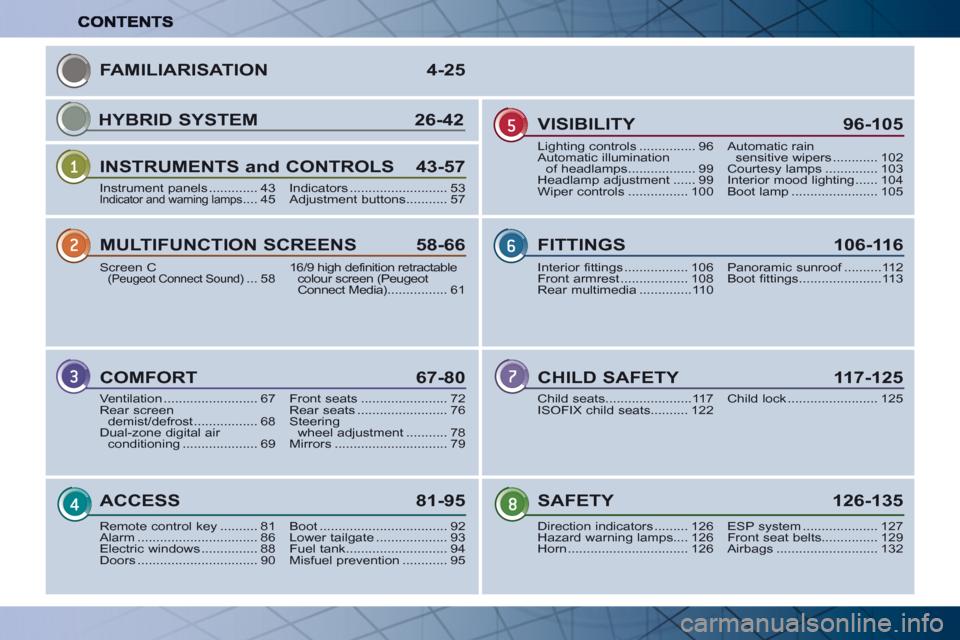
FAMILIARISATION4-25
INSTRUMENTS and CONTROLS 43-57
CHILD SAFETY 117-125
MULTIFUNCTION SCREENS58-66
SAFETY 126-135
COMFORT 67-80
ACCESS 81-95
VISIBILITY 96-105
FITTINGS 106-116
Instrument panels .............43Indicator and warning lamps....45Indicators..........................53Adjustment buttons...........57
Child seats.......................117ISOFIX child seats..........122Child lock........................125
Screen C (Peugeot Connect Sound)...5816/9 high definition retractablecolour screen (PeugeotConnect Media) ................61
Direction indicators.........126Hazard warning lamps....126Horn................................126
ESP system....................127Front seat belts...............129Airbags ...........................132
Ventilation .........................67Rear screen demist/defrost.................68Dual-zone digital air conditioning....................69
Front seats.......................72Rear seats........................76Steering wheel adjustment...........78Mirrors ..............................79
Remote control key..........81Alarm................................86Electric windows...............88Doors ................................90
Boot..................................92Lower tailgate ...................93Fuel tank ...........................94Misfuel prevention ............95
Lighting controls...............96Automatic illumination of headlamps ..................99Headlamp adjustment......99Wiper controls................100
Automatic rainsensitive wipers ............102Courtesy lamps ..............103Interior mood lighting......104Boot lamp.......................105
Interior fittings.................106Front armrest..................108Rear multimedia..............110
Panoramic sunroof..........f112Boot fittings......................113
HYBRID SYSTEM 26-42
Page 11 of 280
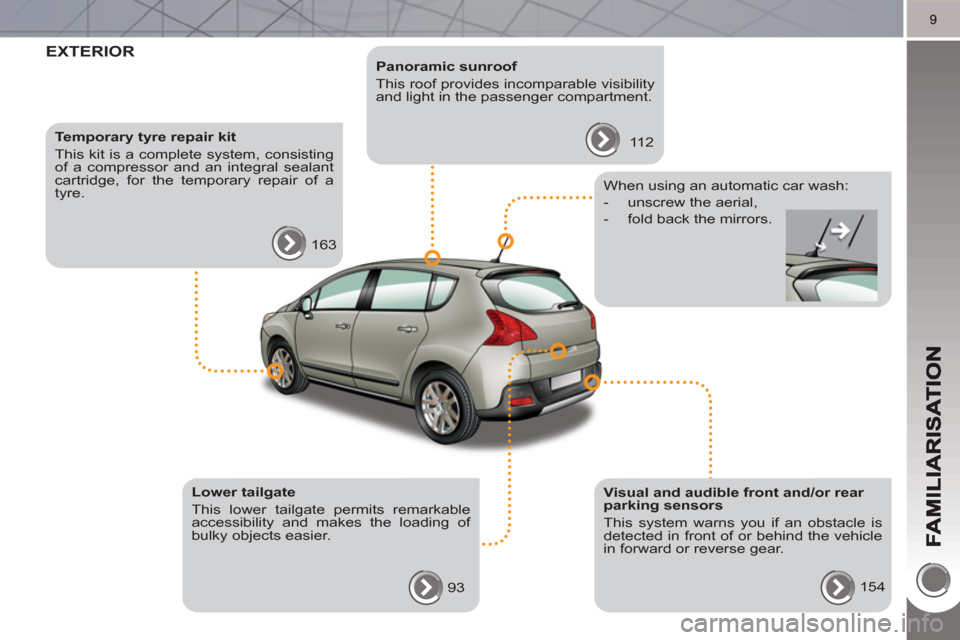
9
EXTERIOR
Panoramic sunroof
This roof provides incomparable visibility
and light in the passenger compartment.
112
Temporary tyre repair kit
This kit is a complete system, consisting
of a compressor and an integral sealant
cartridge, for the temporary repair of a
tyre.
163
Lower tailgate
This lower tailgate permits remarkable
accessibility and makes the loading of
bulky objects easier.
93
Visual and audible front and/or rear
parking sensors
This system warns you if an obstacle is
detected in front of or behind the vehicle
in forward or reverse gear.
154
When using an automatic car wash:
- unscrew the aerial,
- fold back the mirrors.
Page 15 of 280
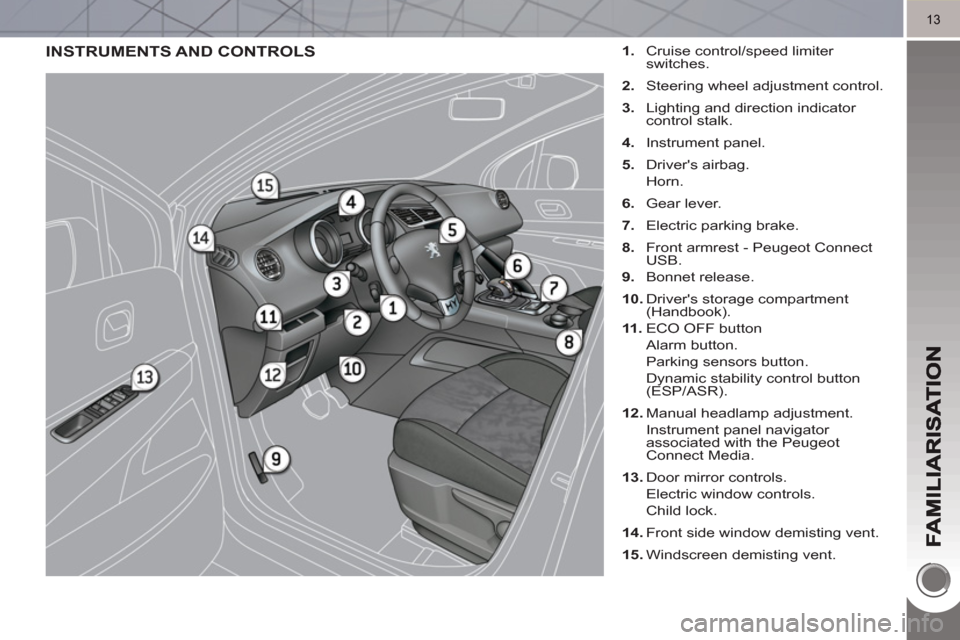
13
INSTRUMENTS AND CONTROLS
1.
Cruise control/speed limiter
switches.
2.
Steering wheel adjustment control.
3.
Lighting and direction indicator
control stalk.
4.
Instrument panel.
5.
Driver's airbag.
Horn.
6.
Gear lever.
7.
Electric parking brake.
8.
Front armrest - Peugeot Connect
USB.
9.
Bonnet release.
10.
Driver's storage compartment
(Handbook).
11 .
ECO OFF button
Alarm button.
Parking sensors button.
Dynamic stability control button
(ESP/ASR).
12.
Manual headlamp adjustment.
Instrument panel navigator
associated with the Peugeot
Connect Media.
13.
Door mirror controls.
Electric window controls.
Child lock.
14.
Front side window demisting vent.
15.
Windscreen demisting vent.
Page 19 of 280
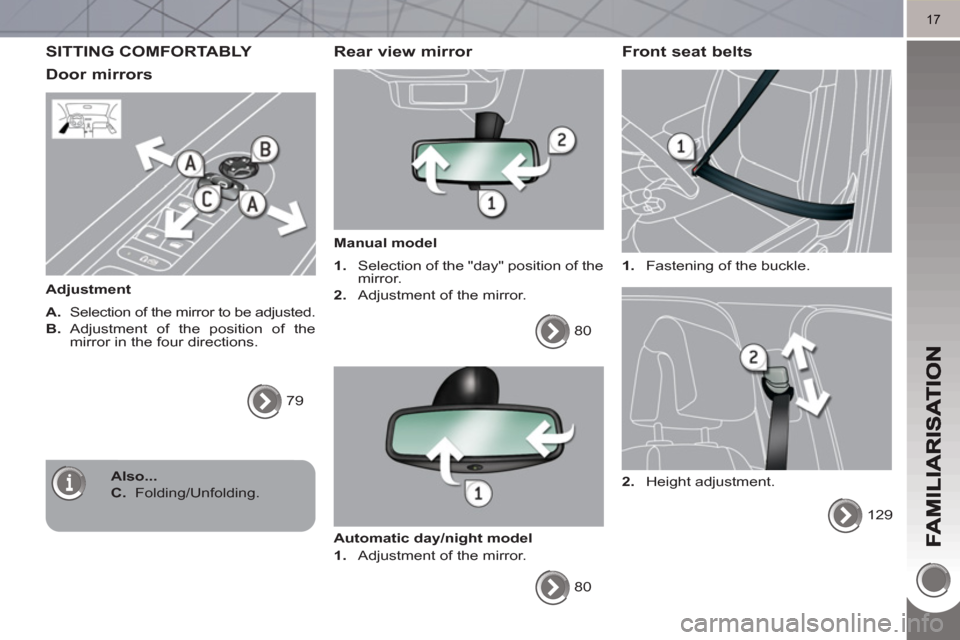
17
SITTING COMFORTABLY
Door mirrors
Adjustment
A.
Selection of the mirror to be adjusted.
B.
Adjustment of the position of the
mirror in the four directions.
79
Rear view mirror
Manual model
1.
Selection of the "day" position of the
mirror.
2.
Adjustment of the mirror.
80
Automatic day/night model
1.
Adjustment of the mirror.
80
Front seat belts
1.
Fastening of the buckle.
129
2.
Height adjustment.
Also...
C.
Folding/Unfolding.
Page 70 of 280
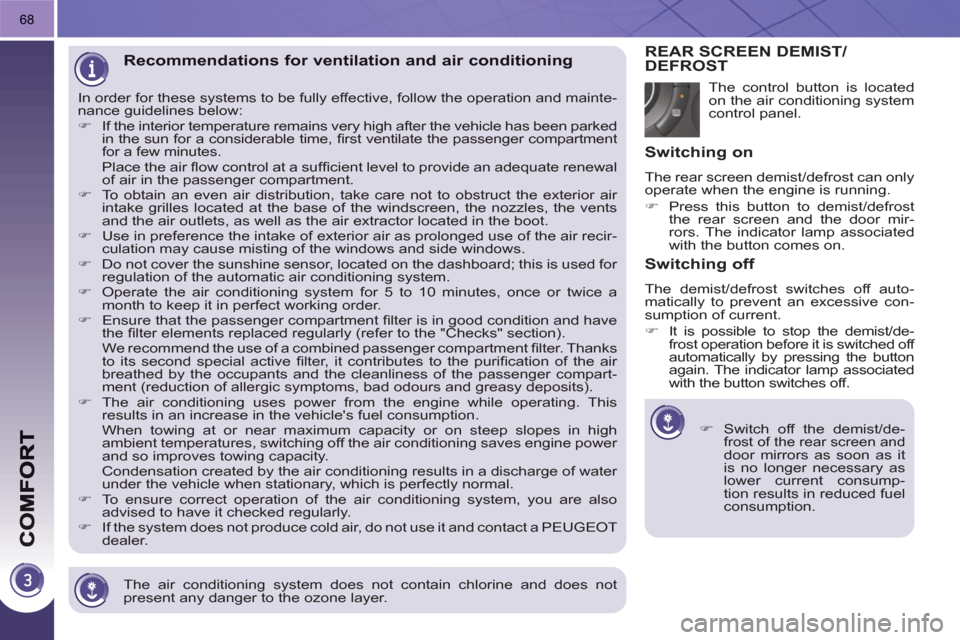
68
The air conditioning system does not contain chlorine and does not
present any danger to the ozone layer.
Recommendations for ventilation and air conditioning
In order for these systems to be fully effective, follow the operation and mainte-
nance guidelines below:
�)
If the interior temperature remains very high after the vehicle has been parked
in the sun for a considerable time, fi rst ventilate the passenger compartment
for a few minutes.
Place the air fl ow control at a suffi cient level to provide an adequate renewal
of air in the passenger compartment.
�)
To obtain an even air distribution, take care not to obstruct the exterior air
intake grilles located at the base of the windscreen, the nozzles, the vents
and the air outlets, as well as the air extractor located in the boot.
�)
Use in preference the intake of exterior air as prolonged use of the air recir-
culation may cause misting of the windows and side windows.
�)
Do not cover the sunshine sensor, located on the dashboard; this is used for
regulation of the automatic air conditioning system.
�)
Operate the air conditioning system for 5 to 10 minutes, once or twice a
month to keep it in perfect working order.
�)
Ensure that the passenger compartment fi lter is in good condition and have
the fi lter elements replaced regularly (refer to the "Checks" section).
We recommend the use of a combined passenger compartment fi lter. Thanks
to its second special active fi lter, it contributes to the purifi cation of the air
breathed by the occupants and the cleanliness of the passenger compart-
ment (reduction of allergic symptoms, bad odours and greasy deposits).
�)
The air conditioning uses power from the engine while operating. This
results in an increase in the vehicle's fuel consumption.
When towing at or near maximum capacity or on steep slopes in high
ambient temperatures, switching off the air conditioning saves engine power
and so improves towing capacity.
Condensation created by the air conditioning results in a discharge of water
under the vehicle when stationary, which is perfectly normal.
�)
To ensure correct operation of the air conditioning system, you are also
advised to have it checked regularly.
�)
If the system does not produce cold air, do not use it and contact a PEUGEOT
dealer. The control button is located
on the air conditioning system
control panel.
REAR SCREEN DEMIST/DEFROST
�)
Switch off the demist/de-frost of the rear screen and door mirrors as soon as it
is no longer necessary as
lower current consump-
tion results in reduced fuel
consumption.
Switching on
The rear screen demist/defrost can only
operate when the engine is running.
�)
Press this button to demist/defrost
the rear screen and the door mir-
rors. The indicator lamp associated
with the button comes on.
Switching off
The demist/defrost switches off auto-
matically to prevent an excessive con-
sumption of current.
�)
It is possible to stop the demist/de-
frost operation before it is switched off
automatically by pressing the button
again. The indicator lamp associated
with the button switches off.
Page 81 of 280
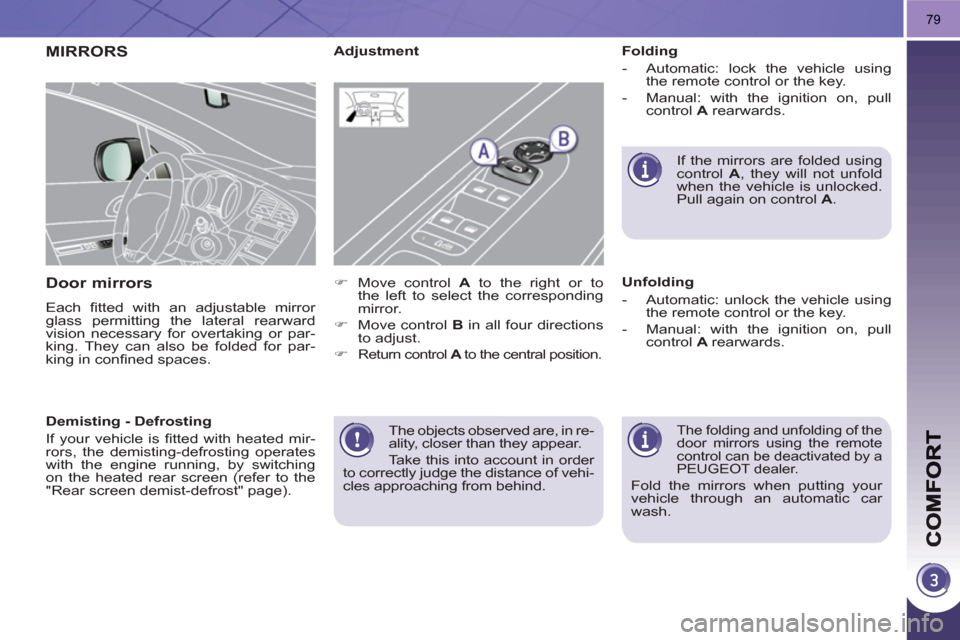
79
The objects observed are, in re-
ality, closer than they appear.
Take this into account in order
to correctly judge the distance of vehi-
cles approaching from behind.
MIRRORS
Door mirrors
Each fi tted with an adjustable mirror
glass permitting the lateral rearward
vision necessary for overtaking or par-
king. They can also be folded for par-
king in confi ned spaces.
Folding
- Automatic: lock the vehicle using
the remote control or the key.
- Manual: with the ignition on, pull
control A
rearwards.
The folding and unfolding of the
door mirrors using the remote
control can be deactivated by a
PEUGEOT dealer.
Fold the mirrors when putting your
vehicle through an automatic car
wash.
Adjustment
Unfolding
- Automatic: unlock the vehicle using
the remote control or the key.
- Manual: with the ignition on, pull
control A
rearwards.
If the mirrors are folded using
control A
, they will not unfold
when the vehicle is unlocked.
Pull again on control A
.
�)
Move control A
to the right or to
the left to select the corresponding
mirror.
�)
Move control B
in all four directions
to adjust.
�)
Return control A
to the central position.
Demisting - Defrosting
If your vehicle is fi tted with heated mir-
rors, the demisting-defrosting operates
with the engine running, by switching
on the heated rear screen (refer to the
"Rear screen demist-defrost" page).
Page 82 of 280
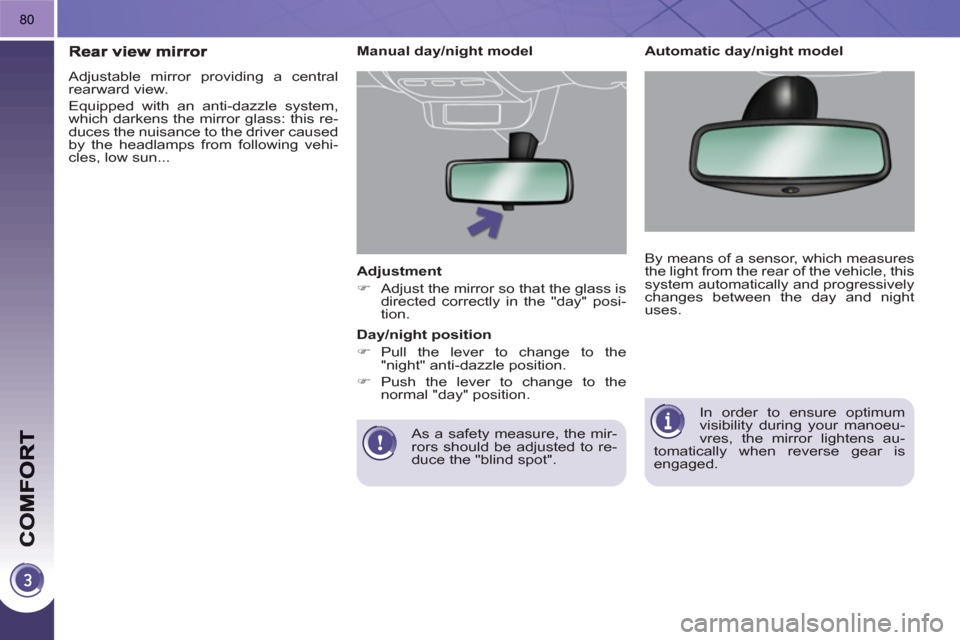
80
Adjustment
�)
Adjust the mirror so that the glass is
directed correctly in the "day" posi-
tion.
As a safety measure, the mir-
rors should be adjusted to re-
duce the "blind spot".
Manual day/night model
Day/night position
�)
Pull the lever to change to the
"night" anti-dazzle position.
�)
Push the lever to change to the
normal "day" position.
Adjustable mirror providing a central
rearward view.
Equipped with an anti-dazzle system,
which darkens the mirror glass: this re-
duces the nuisance to the driver caused
by the headlamps from following vehi-
cles, low sun...
In order to ensure optimum
visibility during your manoeu-
vres, the mirror lightens au-
tomatically when reverse gear is
engaged.
Automatic day/night model
By means of a sensor, which measures
the light from the rear of the vehicle, this
system automatically and progressively
changes between the day and night
uses.
Page 83 of 280

81
Unfolding the key
Unlocking the vehicle
�)
Press the open padlock to
unlock the vehicle.
Complete unlocking using the
remote control
REMOTE CONTROL KEY
System which permits central unlock-
ing or locking of the vehicle using the
lock or from a distance. It is also used to
locate and start the vehicle, as well as
providing protection against theft.
Complete unlocking using the key
�)
Turn the key to the left in the driver's
door lock to unlock the vehicle.
Unlocking is confi rmed by rapid fl ashing
of the direction indicators for approxi-
mately two seconds.
According to version, the door mirrors
unfold at the same time.
Selective unlocking using the
remote control
Selective unlocking using the key
�)
Turn the key to the left in the driver's
door lock once to unlock the driver's
door only.
�)
Turn the key to the left in the driver's
door lock again to unlock the other
doors and the boot.
�)
Press the open padlock
once to unlock the driver's
door only.
�)
Press the open padlock again to un-
lock the other doors and the boot.
Each unlocking is confi rmed by rapid
fl ashing of the direction indicators for
approximately two seconds.
According to version, the door mirrors
unfold at the same time as the fi rst un-
locking action.
The selective unlocking is only available
on versions fi tted with deadlocking.
The complete or selective
unlocking parameter is set
via the multifunction screen
confi guration menu.
Complete unlocking is activated by
default.
�)
First press this button to
unfold the key.
Page 84 of 280
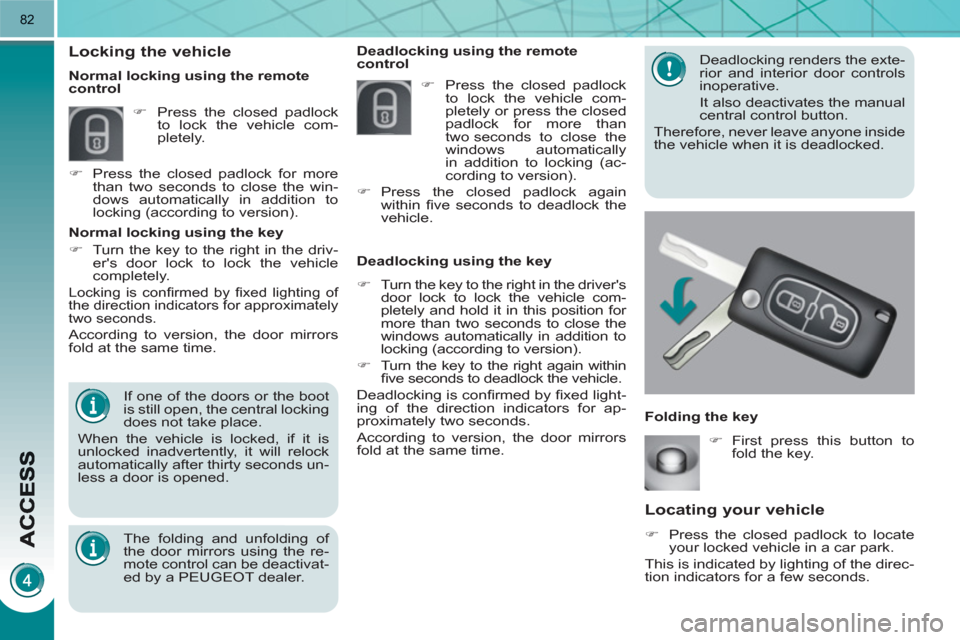
82
Locating your vehicle
�)
Press the closed padlock to locate
your locked vehicle in a car park.
This is indicated by lighting of the direc-
tion indicators for a few seconds. Deadlocking renders the exte-
rior and interior door controls
inoperative.
It also deactivates the manual
central control button.
Therefore, never leave anyone inside
the vehicle when it is deadlocked.
Deadlocking using the remote
control
Deadlocking using the key
Folding the key
�)
Press the closed padlock
to lock the vehicle com-
pletely or press the closed
padlock for more than
two seconds to close the
windows automatically
in addition to locking (ac-
cording to version).
�)
Press the closed padlock again
within fi ve seconds to deadlock the
vehicle.
If one of the doors or the boot
is still open, the central locking
does not take place.
When the vehicle is locked, if it is
unlocked inadvertently, it will relock
automatically after thirty seconds un-
less a door is opened.
Normal locking using the key
�)
Turn the key to the right in the driv-
er's door lock to lock the vehicle
completely.
Locking is confi rmed by fi xed lighting of
the direction indicators for approximately
two seconds.
According to version, the door mirrors
fold at the same time.
The folding and unfolding of
the door mirrors using the re-
mote control can be deactivat-
ed by a PEUGEOT dealer.
Locking the vehicle
�)
Press the closed padlock
to lock the vehicle com-
pletely.
�)
Press the closed padlock for more
than two seconds to close the win-
dows automatically in addition to
locking (according to version).
Normal locking using the remote
control
�)
Turn the key to the right in the driver's
door lock to lock the vehicle com-
pletely and hold it in this position for
more than two seconds to close the
windows automatically in addition to
locking (according to version).
�)
Turn the key to the right again within
fi ve seconds to deadlock the vehicle.
Deadlocking is confi rmed by fi xed light-
ing of the direction indicators for ap-
proximately two seconds.
According to version, the door mirrors
fold at the same time.
�)
First press this button to
fold the key.
Page 101 of 280

99
In fog or snow, the sunshine
sensor may detect suffi cient
light. Therefore, the lighting
will not come on automatically.
Do not cover the sunshine sensor,
coupled with the rain sensor and lo-
cated in the centre of the windscreen
behind the rear view mirror; the as-
sociated functions would no longer
be controlled.
Associated with the automatic
"Guide-me-home" lighting
Association with the automatic lighting
provides the "guide-me-home" lighting
with the following additional options:
- selection of the lighting duration of
15, 30 or 60 seconds in the vehicle
parameters on the multifunction
screen confi guration menu,
-
automatic activation of "guide-me-home"
lighting when automatic lighting is in
operation.
Automatic illumination of headlamps
The sidelamps and dipped beam head-
lamps are switched on automatically,
without any action on the part of the
driver, when a low level of external light
is detected or in certain cases of activa-
tion of the windscreen wipers.
As soon as the brightness returns to a
suffi cient level or after the windscreen
wipers are switched off, the lamps are
switched off automatically.
Activation
�)
Turn the ring to the "AUTO"
position.
The automatic illumination of head-
lamps is accompanied by a mes-
sage on the multifunction screen.
Deactivation
�)
Turn the ring to another position.
Deactivation is accompanied by
a message on the multifunction
screen.
Operating fault
In the event of a malfunction of
the sunshine sensor, the light-
ing comes on, this warning
lamp is displayed on the instru-
ment panel and/or a message appears
on the multifunction screen, accompa-
nied by an audible signal.
Consult a PEUGEOT dealer.
MANUAL ADJUSTMENT OF
HALOGEN HEADLAMPS
The initial setting is position "0"
.
To avoid causing a nuisance to other
road users, the height of the halogen
headlamps should be adjusted accord-
ing to the load in the vehicle.
0.
1 or 2 people in the front seats.
-.
3 people.
1.
5 people.
-.
Intermediate setting.
2.
5 people + maximum authorised
load.
-.
Intermediate setting.
3.
Driver + maximum authorised load.